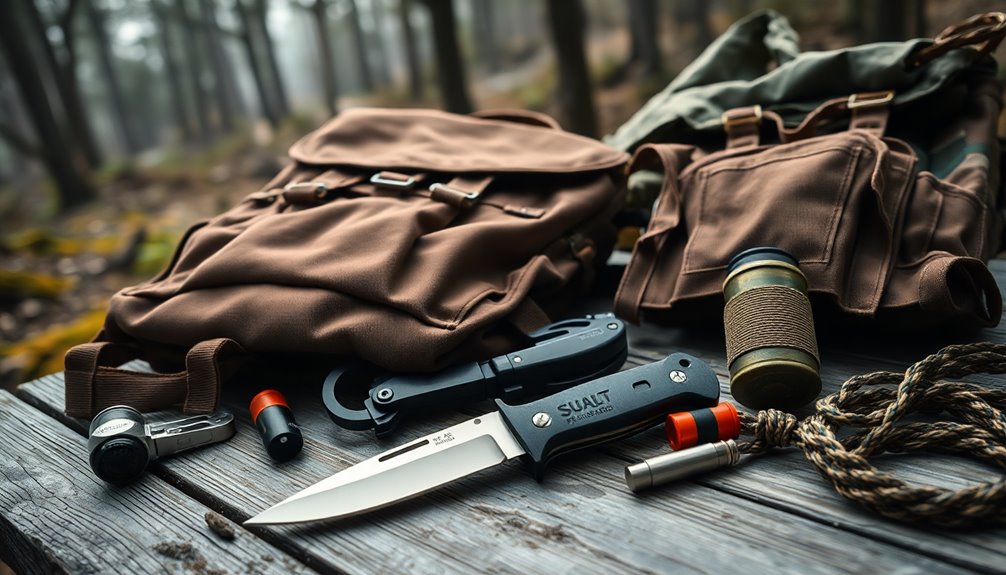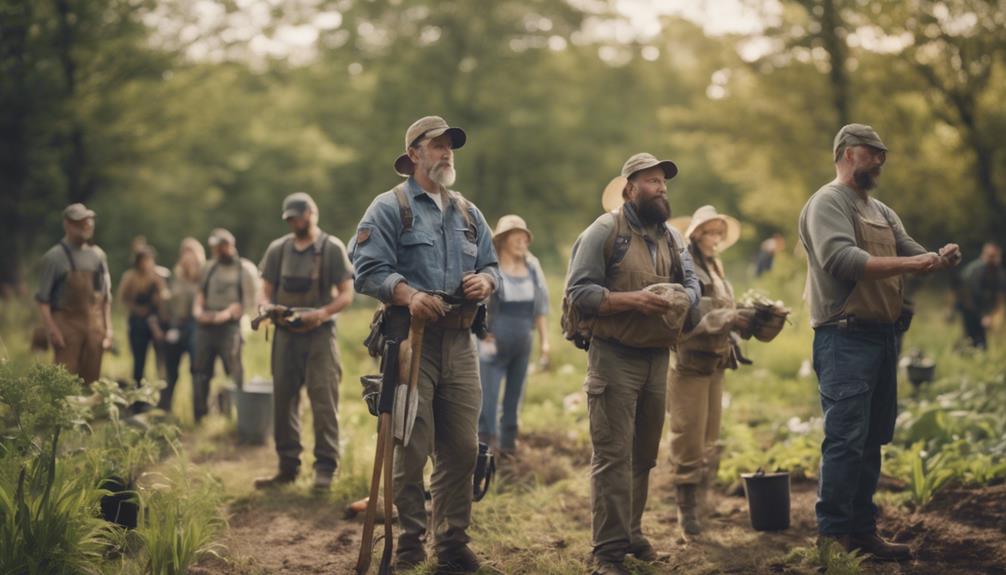To arm yourself against society's collapse, start with a solid gear list. You'll need at least a gallon of water per person daily, along with purification tablets. Stock non-perishable foods like canned goods and freeze-dried meals, guaranteeing sustainable long-term storage. First aid kits should include bandages, medications, and trauma supplies. For shelter, consider tents and sleeping bags that retain warmth. Security's crucial, so pack firearms and establish physical barriers. Communication methods like two-way radios and emergency signaling devices are essential. With the right approach, you can guarantee your readiness for any situation, and there's more to cover on this journey.
Key Takeaways
- Stockpile essential non-perishable foods and water supplies to sustain yourself during extended emergencies and societal disruptions.
- Equip yourself with a comprehensive first aid kit, including trauma supplies, to handle injuries effectively when medical help is unavailable.
- Ensure reliable shelter and warmth by using tents, sleeping bags, and portable heating solutions to protect against harsh weather conditions.
- Maintain communication and navigation capabilities with two-way radios, maps, and signaling devices to stay connected and find your way.
- Arm yourself with self-defense tools, including firearms and personal safety training, to protect yourself against potential threats and dangers.
Essential Water Supply Strategies
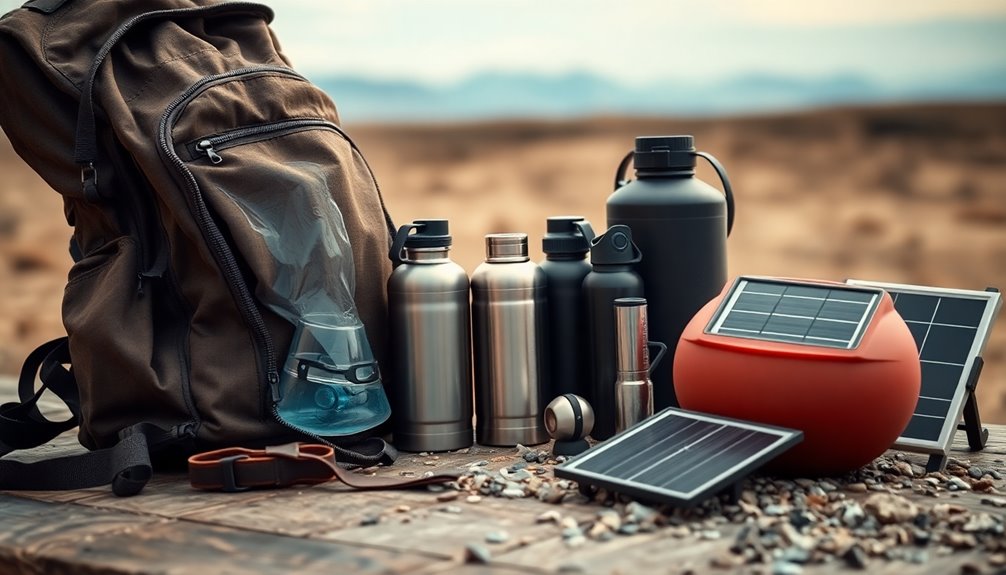
When preparing for an emergency, one of the most essential steps is guaranteeing you have a reliable water supply. In the United States, you should aim for at least one gallon of water per person per day for drinking and hygiene.
Don't forget to include water purification tablets to make untreated water safe for consumption.
To enhance your water supply, consider implementing a rainwater collection system. Use food-grade storage containers to prevent contamination, guaranteeing everything you need is safe to use.
When traveling, portable water filters are vital. They allow you to access clean water from natural sources wherever you are.
Regularly inspect and rotate your water storage to avoid stagnation and maintain high-quality supplies. This guarantees you always have fresh water when you need it most.
Additionally, familiarize yourself with local water sources and their purification methods. Knowing how to access and purify water in your area can be a game-changer during emergencies.
Long-Term Food Storage Solutions
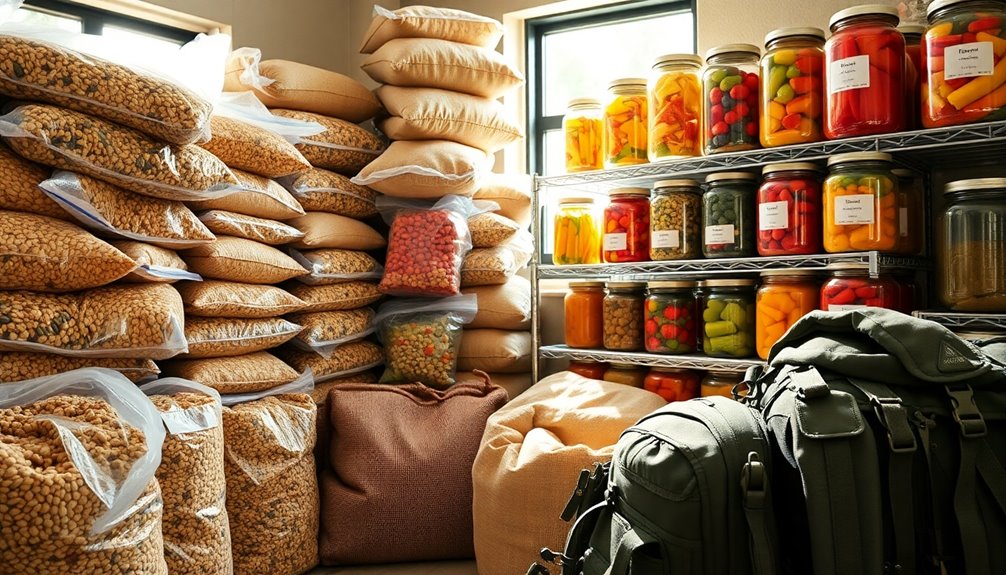
Securing a reliable food supply is just as essential as guaranteeing access to clean water during emergencies. Non-perishable foods, like canned goods and dried grains such as rice and beans, are vital for long-term storage due to their extended shelf lives. They'll provide the necessary nutrition you need when fresh food isn't available.
Consider incorporating freeze-dried meals into your stockpile. With a shelf life of 25 years or more, these lightweight and compact options are perfect for easy transport and quick meals.
Regularly rotating your food supplies is key; this practice helps prevent spoilage and guarantees everything stays within ideal consumption dates.
When it comes to buying, bulk purchasing non-perishable items can save you money, allowing you to take advantage of sales or discounts. However, make sure to store your food in proper food-grade containers to avoid contamination.
Keeping your supplies in a cool, dark place will maximize their longevity, ensuring you're prepared for any situation. By planning ahead and following these strategies, you'll secure a sustainable food source that can carry you through tough times.
Comprehensive First Aid Kits
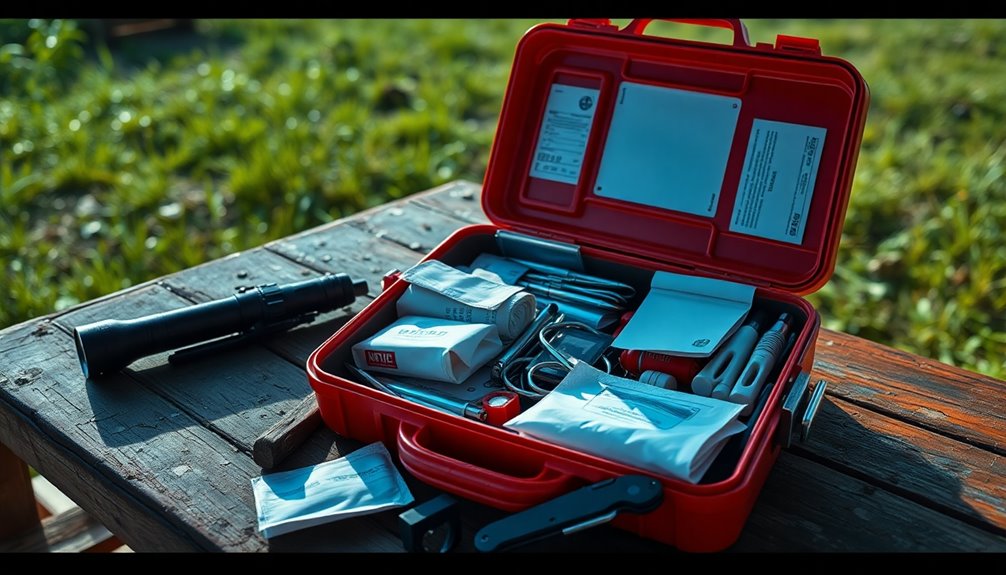
Being prepared for emergencies is essential, and a thorough first aid kit is an important component of your readiness. Your kit should include essential items like bandages, antiseptics, gauze, and adhesive tape to treat minor injuries and help prevent infection.
Don't forget to pack pain relievers like ibuprofen or acetaminophen to manage discomfort and reduce fever during medical emergencies.
It's imperative to stock prescription medications, ensuring you have enough supply for ongoing health conditions and unexpected situations. Additionally, emergency trauma supplies such as tourniquets and hemostatic dressings are critical for controlling severe bleeding and addressing life-threatening injuries.
Remember, having the right supplies isn't enough; familiarity with first aid techniques like CPR and wound care enhances your kit's effectiveness. Take the time to learn these skills, as they'll prepare you to respond confidently in emergencies. Including multi-functional gear in your first aid kit can optimize space and ensure you have the right tools for various situations.
Regularly check your kit to replace expired items and assess your needs. A well-stocked, extensive first aid kit can make all the difference when disaster strikes, so invest the time to prepare now. Your health and safety may depend on it.
Effective Shelter and Warmth Options

In emergencies, having effective shelter and warmth options is essential for survival. You need to protect yourself from the elements, maintain body heat, and guarantee comfort during tough times.
Here are four fundamental items to keep in mind:
- Tents and Tarps: These are imperative for creating a temporary shelter. They shield you from rain, wind, and snow, providing a safe place to rest.
- Sleeping Bags: Invest in sleeping bags rated for low temperatures. They're designed to trap heat, keeping you warm and cozy when the temperature plummets at night.
- Portable Heaters or Wood Stoves: These can be lifesavers for warmth and cooking, especially when power sources are unreliable. A good stove not only warms your space but also allows you to prepare meals.
- Insulation Materials: Blankets or foam can greatly enhance warmth within your shelter. They help retain heat, making your environment much more livable in harsh conditions.
Don't forget fire-starting tools like matches or lighters; they'll be essential for warmth and cooking.
Prioritize these options to secure your survival when it matters most.
Must-Have Tools and Equipment
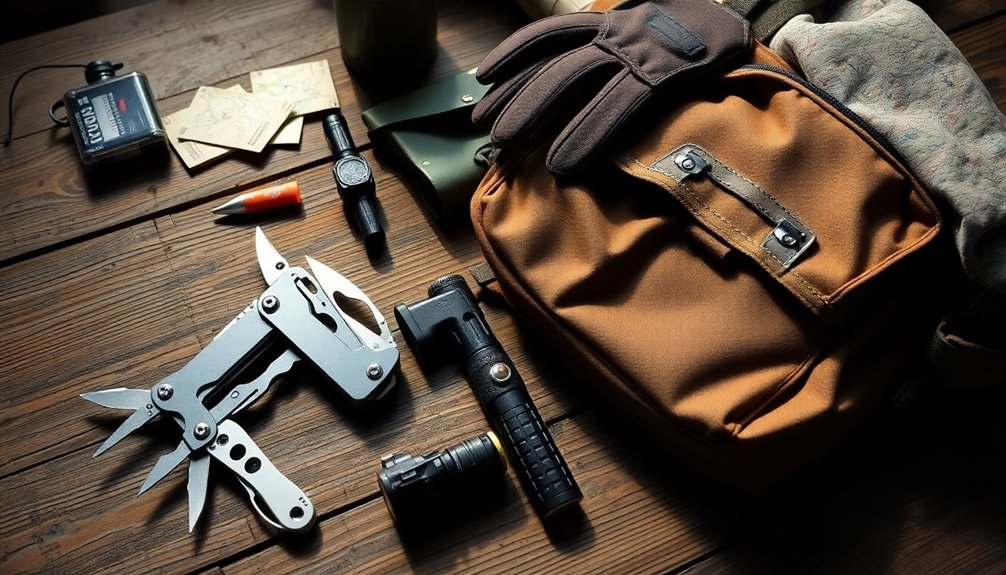
When it comes to survival situations, having the right tools and equipment can make all the difference. First on your list should be a multi-tool. This compact device combines cutting, screwing, and prying functions, providing versatility for countless tasks you might face.
Additionally, hand saws and axes are vital for gathering wood, whether you need it for shelter or fire.
Don't underestimate the power of rope and duct tape, either. These items are indispensable for securing gear, making repairs, or even crafting makeshift shelters in an emergency.
A sturdy shovel and gardening tools are also essential; they'll help you cultivate food and manage waste, creating a sustainable living environment.
Lastly, invest in reliable flashlights and extra batteries. They'll guarantee you have visibility during power outages, allowing you to navigate safely and maintain your daily routines even in low-light conditions.
Consider also incorporating essential survival skills such as fire-making and navigation, as these will greatly enhance your readiness for unexpected challenges.
With these must-have tools and equipment, you'll be better equipped to handle the challenges that arise during a crisis, enhancing your chances of survival and self-sufficiency.
Security and Self-Defense Measures

Safety is a fundamental concern in any survival situation, and implementing effective security and self-defense measures is essential.
You need to equip yourself with the right tools and knowledge to protect yourself and your loved ones during a potential societal collapse. Here are some critical measures to take into account:
- Firearms and ammunition: Proper training and legal ownership of firearms can deter potential threats and provide you with a means of defense.
- Security alarms and noise-making devices: These early warning systems alert you to intruders, enhancing your overall safety and giving you precious time to react.
- Physical barriers: Establishing fencing or fortified doors greatly reduces the risk of unauthorized access to your property, creating a secure haven.
- Surveillance equipment: Cameras and motion detectors help monitor your surroundings and provide valuable evidence in case of security breaches.
Don't underestimate the power of self-defense training, either.
It equips you with the skills needed to handle high-stress situations, boosting your confidence and preparedness.
Communication and Navigation Devices
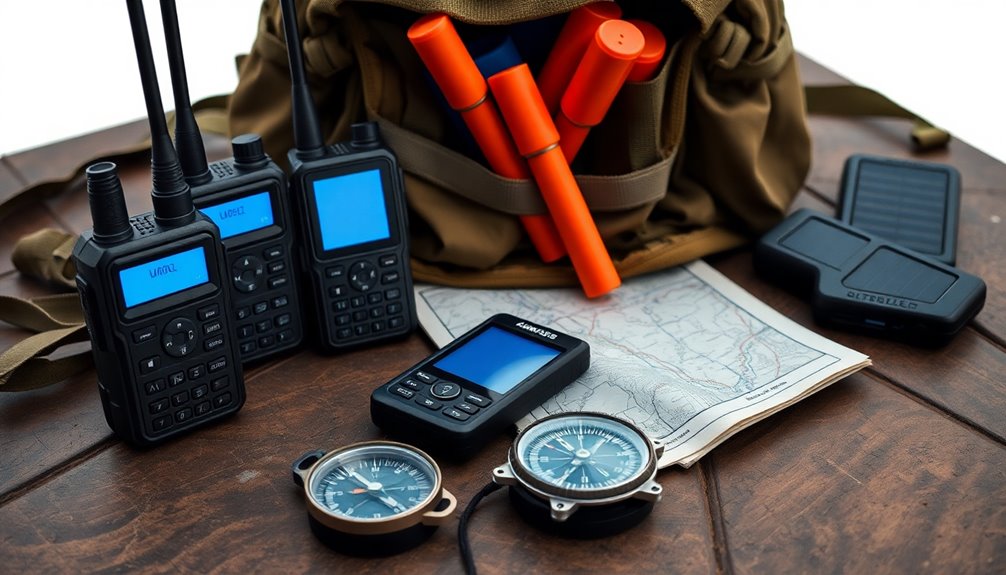
Effective communication and navigation are just as essential as security measures in a survival scenario. In the event of a societal collapse, two-way radios become critical for local communication. They enable you to coordinate with others without relying on unreliable cellular networks.
Pair these radios with solar-powered chargers to keep them operational when traditional power sources are unavailable. Backup batteries are equally significant for essential electronics, ensuring you maintain communication capabilities even when electricity is compromised.
Don't underestimate the value of emergency whistles. These lightweight signaling devices can alert others to your location without needing any electronic means.
When it comes to navigation, printed maps are indispensable. They provide a reliable method for route planning and help you familiarize yourself with the terrain when GPS fails.
Transportation and Mobility Solutions

In a survival situation, having reliable transportation and mobility solutions greatly increases your chances of reaching safety and securing resources. You need options that don't rely solely on fuel, as scarcity can cripple your mobility.
Here are four essential solutions to evaluate:
- Bicycles: They're efficient, fuel-free, and can take you places where vehicles can't go. Plus, they help you stay fit!
- Fuel Storage: Keep a supply of fuel for your vehicle, but make sure you also have maintenance tools ready. A well-maintained vehicle can be a lifesaver.
- Sturdy Backpacks: Invest in a quality backpack to carry essential gear. You'll appreciate the practicality when you need to travel on foot.
- Local Terrain Knowledge: Familiarize yourself with your surroundings. Knowing safe routes helps you avoid threats while finding resources.
Additionally, consider incorporating solar pool covers to enhance your sustainability in maintaining water resources for essential needs.
Having a diverse array of transportation options—walking, cycling, and operational vehicles—will enhance your mobility and adaptability.
In times of chaos, these solutions will be your lifeline, allowing you to navigate an unpredictable landscape effectively.
Stay prepared, and you'll stand a better chance of thriving when society collapses.
Frequently Asked Questions
What Are the Best Methods for Bartering in a Collapsed Society?
In a collapsed society, bartering becomes vital for survival.
You'll want to identify valuable goods or services that others need, like food, tools, or medical supplies.
Building relationships is important; trust plays a big role in successful trades.
Always be clear about what you're offering and what you want in return.
Flexibility helps, so be prepared to negotiate.
Finally, keep an eye on community needs, adjusting your offerings accordingly to guarantee you're valuable.
How Can I Enhance My Skills for Resource Management?
In a world where you might need to channel your inner MacGyver, enhancing your resource management skills is essential.
Start by practicing budgeting in your daily life; track your expenses and identify areas to cut back. Learn about permaculture to maximize food production and minimize waste.
Participate in community workshops or online courses to expand your knowledge.
Finally, regularly assess your resources and find creative ways to repurpose them, ensuring nothing goes to waste.
What Lightweight Clothing Is Essential During a Societal Collapse?
When considering lightweight clothing, focus on durability and versatility. Opt for moisture-wicking fabrics that dry quickly and keep you comfortable in various conditions.
Choose breathable layers, like lightweight long-sleeve shirts and cargo pants, to protect against sun exposure and insects. Don't forget a sturdy pair of shoes that can handle rugged terrain.
A wide-brimmed hat and a lightweight jacket can also shield you from the elements while keeping your load light and manageable.
How Do I Identify Safe Locations for Shelter?
To identify safe locations for shelter, start by observing your surroundings.
Look for high ground to avoid flooding and areas with natural barriers, like mountains or rivers, which can deter threats.
Check for accessibility to resources like water and food.
Avoid isolated spots; you want a place that's defensible yet offers escape routes.
Stay away from buildings that appear abandoned or damaged, as they might harbor dangers.
Trust your instincts and stay alert.
What Personal Hygiene Items Should I Prioritize for Long-Term Survival?
When you're preparing for long-term survival, prioritize essential personal hygiene items to maintain your health.
Start with biodegradable soap, toothbrushes, toothpaste, and menstrual products if applicable.
Don't forget a sturdy comb, nail clippers, and a first-aid kit stocked with antiseptics.
Pack items like toilet paper, wet wipes, and hand sanitizer to keep clean in challenging situations.
Staying hygienic will help you avoid infections and boost your overall well-being during tough times.
Conclusion
In a world where 60% of Americans aren’t prepared for a disaster, it’s vital to take action now. By investing in essential gear and strategies, you’re not just protecting yourself; you’re also ensuring your loved ones’ safety. Remember, being proactive can make all the difference when society faces collapse. So arm yourself with knowledge and supplies, and don’t wait until it’s too late. The time to prepare is now—your future self will thank you! And don’t let financial constraints hold you back. There are many resources available for obtaining essential gear, including emergency preparedness kits and tactical gear for free. Look for community programs, government assistance, and non-profit organizations that can help you acquire the necessary supplies. Taking action now can make all the difference in a crisis, so don’t hesitate to seek out these resources to ensure your readiness.

